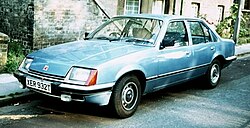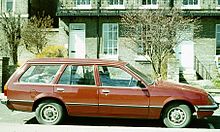Vauxhall Carlton
| Vauxhall Carlton | |
|---|---|
| Production period: | 1978-1994 |
| Class : | upper middle class |
| Body versions : | Limousine , station wagon |
| Previous model: | Vauxhall Victor |
| Successor: | Vauxhall Omega |
The Vauxhall Carlton is an upper middle class passenger car that Vauxhall sold in the UK from late 1978 to spring 1994 .
Carlton (Mark I, 1978-1986)
| 1st generation | |
|---|---|
|
Vauxhall Carlton (1978-1982) |
|
| Production period: | 1978-1986 |
| Body versions : | Limousine , station wagon |
| Engines: |
Otto engines : 1.8–2.2 liters (66–85 kW) Diesel engines : 2.3 liters (52–63 kW) |
| Length: | 4620-4678 mm |
| Width: | 1720-1726 mm |
| Height: | 1470 mm |
| Wheelbase : | 2668 mm |
| Empty weight : | 1145-1305 kg |
The first Vauxhall Carlton was introduced in late 1978 as a replacement for the Vauxhall VX . It was based on the contemporary Opel Rekord , but had the “droopsnoot” typical of Vauxhall (front section lowered between the headlights) and therefore no usual radiator grille. The cars were available as a sedan or station wagon with rear-wheel drive and a large, comfortable interior (initially only in "L" equipment). The drive was a four-cylinder in-line engine with a displacement of 2.0 liters and a carburettor, which gave the car sufficient power and was characterized by its smoothness and economy.
There were some interesting optional extras, such as central locking, aluminum rims and power windows, which was already unusual for a high-volume model in the late 1970s.
There were also elongated and stronger models based on the Carlton and the Rekord. Directly above it was the Vauxhall Viceroy - almost identical to the Opel Commodore - and above it was the Vauxhall Royale - an Opel Senator - and its coupé variants, the Vauxhall Royale Coupé or the Opel Monza . Of the latter, the Opel versions were also more widespread in Great Britain than their Vauxhall counterparts.
Facelift
In a facelift carried out at the end of 1982 , the “droopsnoot” typical of Vauxhall was eliminated and the rectangular radiator grille corresponded to that of the Opel.
At this time, the marketing of Opel models in Great Britain was also discontinued, as apart from the emblems, there were no longer any differences to Opel. As with the Rekord E, additional engines were introduced during the revision: a 1.8 l R4 carburettor engine and a 2.3 l R4 diesel engine. In addition to the entry-level variant “L”, the other equipment lines “GL” and “CD” were also introduced.
1984 came a 2.0-liter in-line four-cylinder injection engine, which was replaced by a 2.2-liter in 1985.
Carlton (Mark II, 1986-1994)
| 2nd generation | |
|---|---|
|
Vauxhall Carlton (1986-1994) |
|
| Production period: | 1986-1994 |
| Body versions : | Limousine , station wagon |
| Engines: |
Otto engines : 1.8–3.6 liters (66–277 kW) Diesel engines : 2.3 liters (52–74 kW) |
| Length: | 4738 mm |
| Width: | 1760 mm |
| Height: | 1445 mm |
| Wheelbase : | 2730 mm |
| Empty weight : | 1150-1370 kg |
Opel decided to offer the successor to the last Opel Rekord presented in autumn 1986 under the name Omega . Vauxhall left it at the previous name "Carlton".
When they were launched, the sister models Vauxhall Carlton Mark II and Opel Omega A, which in turn were available as sedans and station wagons, won the Car of the Year award in 1987.
Here, too, there was an extended version of the Vauxhall Carlton and Opel Omega. It was called Senator by both manufacturers .
When the first series was replaced by the Omega B at Opel in the spring of 1994 , Vauxhall now also gave up the name Carlton and also called their model Omega. Apparently, the GM subsidiaries were striving for uniform names for models of equal value.
Engine range
New to the Carlton Mark II's engine range were two in-line six-cylinder engines with a displacement of 2.6 and 3.0 liters. Initially equipped with 12 valves, engines with 24 valves were later offered, which could develop significantly more power and torque. In addition, Vauxhall used the "Dual-Ram" -Ansaugkrümmer which the engines under 4,000 min -1 ran as two 3-cylinder units, which at 4,000 rpm -1 but changed the Ansaugprofil and thus significantly increased engine performance.
Lotus version
In 1990 Vauxhall brought out the high-performance car Lotus Carlton in collaboration with Lotus Cars with 377 bhp (277 kW). At Opel, the vehicle was called Lotus Omega . It had an in-line six-cylinder engine with a displacement of 3,615 cm³ and two turbochargers (factory designation: C36GET). The car had a top speed of around 283 km / h, which officially made it the fastest four-seater ever built.
It cost £ 48,000, which was over double a standard Carlton. Due to the high price, Vauxhall was only able to sell 440 copies instead of the planned 1,000 in Great Britain. For less well-heeled customers there was an alternative to the 3000 GSi 24V , which also ensured good driving performance with a top speed of almost 240 km / h.
Web links
- Total Carlton - Website for the Vauxhall Carlton / Opel Omega A enthusiast



